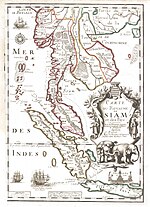Canasapura
Canasapura | |
|---|---|
| 7th century–970 | |
| Capital | Muang Sema |
| Religion | Buddhism, Hinduism |
| Government | Monarchy |
| Historical era | 7th-10th century |
• Established | 7th century |
• Disestablished | 970 |
| Today part of | Thailand |
| History of Thailand |
|---|
 |
|
|
Canasapura or Canāśa, Śri Canāśa (Thai: จนาศปุระ, จานาศปุระ, ศรีจนาศะ,[1] Chinese: 迦羅舍) is an ancient kingdom located in the upper valley of the Mun River, in present-day Isan, the northeastern region of Thailand.[2][3] The kingdom was mentioned in the No. 118 Bô Ika inscription (K. 400), founded in Muang Sema, Nakhon Ratchasima Province, dated to c. 790 CE,[4] and also in the No. 117 Śri Canāśa inscription, founded in Phra Nakhon Si Ayutthaya.[5]
History
[edit]The kingdom was mentioned in inscription K. 400 (IC VI, pp. 83–85), which was transcribed into English as:[6]
Twenty female buffalos with pendant udders (lambastanyaḥ) and having baby calves, and fifty milch cows, heavy with the burden of their udders, followed by their well-nourished calves, ten female and male slaves, happy in their minds, and four elephants were given to the [Buddhist] community by the king of Canāśa, whose mind was fixed upon awakening.
An inscription in Sanskrit and Khmer, found in Ayutthaya in 1939, dated 937 A.D., mentions four rulers of Sri Canasa, starting with the first king named Bhagadatta (Thai: ภคทัตต์, RTGS: Phakkhathat), followed by Sri Sundaraprakrama (ศรีสุนทรปรากรม, Si Sunthra Prakom), who had a son named Sri Sundararavarman (ศรีสุนทรวรมัน, Si Sunthra Woraman) and King Sri Sundararavarman had 2 sons, the elder named Narapatisimhavarman (ศรีนรปติสิงหวรมัน, Si Naruepati Singha Woraman) who later ascended the throne of the Sri Canasa kingdom. His younger brother, Mangalavarman (มงคลวรมัน, Mongkhon Woraman), created this inscription to celebrate the creation of the image of the queen mother, the wife of Lord Shiva, in 859 CE.[5]
The time of the establishment of Sri Canasa is still unknown. It probably existed parallel to the Dvaravati culture of the Mon in what is now central Thailand. According to the inscriptions of Bo Ika and Sri Canasa written in Khmer, it must have been located on the periphery of the sphere of influence of Dvaravati, a network of city-states in the Chao Phraya Plain. According to these texts, both Hinduism and Buddhism were practiced in the community.[7]
After the reign of Narapatisimhavarman, Sri Canasa has disappeared from history. It is possible that it was merged with the Khmer Empire during the reign of King Jayavarman V, according to the inscription of the ancient city of Sema (dated c. 970 CE), which mentions the name of Driḍhabhakti Simhavarman (ทฤฒภักดี สิงหวรมัน, Thritthaphakdi Singha Woraman), which is assumed to be the new royal name of Narapatisimhavarman, whose role was reduced.[8]
References
[edit]- ^ Songtham Pansakun (2011). "A Study of Place in Khmer Kingdom" (PDF) (in Thai). Silpakorn University. Archived from the original (PDF) on 1 April 2023. Retrieved 26 September 2023.
- ^ Higham: Encyclopedia of Ancient Asian Civilizations. 2004, S. 63.
- ^ Goodall & Revire 2023, p. 292.
- ^ "จารึกบ่ออีกา" (in Thai). Princess Maha Chakri Sirindhorn Anthropology Centre. 2023. Retrieved 26 September 2023.
- ^ a b "จารึกศรีจานาศะ" (in Thai). Princess Maha Chakri Sirindhorn Anthropology Centre. 2023. Retrieved 26 September 2023.
- ^ Goodall & Revire 2023, p. 283.
- ^ Dhida Saraya: (Sri) Dvaravati. The Initial Phase of Siam’s History. Muang Boran Publishing, Bangkok 1999. Zitiert nach Dougald J.W. O'Reilly: Early Civilizations of Southeast Asia. AltaMira Press, Lanham MD/Plymouth 2007, S. 82.
- ^ "จารึกเมืองเสมา" (in Thai). Princess Maha Chakri Sirindhorn Anthropology Centre. 2023. Retrieved 26 September 2023.
Bibliography
[edit]- Goodall, Dominic; Revire, Nicolas (2023). "East and West - New Inscriptions from Funan, Zhenla and Dvāravatī". École française d’Extrême-Orient. p. 292. Archived from the original on 25 September 2023.
